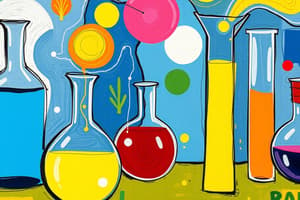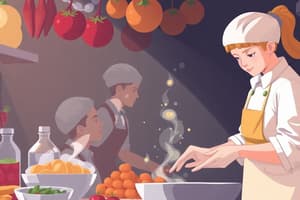Podcast
Questions and Answers
What is the water activity limit for the growth of molds and yeasts?
What is the water activity limit for the growth of molds and yeasts?
Between 0.8 and 0.9
What water activity level is required for most enzymatic reactions?
What water activity level is required for most enzymatic reactions?
0.85 or higher
What is the relationship between water activity and chemical reactions?
What is the relationship between water activity and chemical reactions?
Exhibits more complex behavior with maxima and minima
What is the glassy state in foods?
What is the glassy state in foods?
What is the subject of strong interest among food scientists?
What is the subject of strong interest among food scientists?
What are the two variables that affect the physical properties and stability of a concentrated aqueous solution of sugars?
What are the two variables that affect the physical properties and stability of a concentrated aqueous solution of sugars?
What happens when the concentration of a liquid food product is increased by slowly removing some of the water and the temperature is lowered gradually?
What happens when the concentration of a liquid food product is increased by slowly removing some of the water and the temperature is lowered gradually?
What is the result of carrying out the process of concentration and cooling under different conditions?
What is the result of carrying out the process of concentration and cooling under different conditions?
What is an example of a glassy (vitreous) food?
What is an example of a glassy (vitreous) food?
Is the glassy state limited to sugar-water systems?
Is the glassy state limited to sugar-water systems?
Flashcards are hidden until you start studying
Study Notes
Water Activity and Microbial Growth
- Bacterial growth is inhibited at water activity levels below 0.9.
- Molds and yeasts generally do not thrive at water activity levels below 0.8, with osmophilic species as an exception.
- Most enzymatic reactions necessitate water activity levels of 0.85 or higher.
- The relationship between water activity and chemical reactions like Maillard browning and lipid oxidation displays complex behavior, including maxima and minima.
Glassy State in Foods
- Foods should be viewed as metastable systems that can undergo changes.
- The stability of foods is influenced by the rate of change, which is dependent on molecular mobility.
- Molecular mobility is particularly significant in solid and semi-solid foods with low to intermediate water content.
- Water and solutes play a crucial role in molecular mobility, diffusion, and reaction rates within food systems.
- Concepts from polymer science are increasingly applied to understand food stability and behavior.
Examples of Phase Transition: Honey and Candy
- A concentrated aqueous solution of sugars, like honey, exhibits stability based on concentration and temperature.
- Increasing concentration by removing water and lowering temperature results in sugar crystallization.
- Different processing conditions can prevent crystallization, leading to increased viscosity and formation of a rigid, glass-like state.
- Hard candy exemplifies a glassy (vitreous) food, highlighting the transition from liquid to glassy state.
Studying That Suits You
Use AI to generate personalized quizzes and flashcards to suit your learning preferences.




